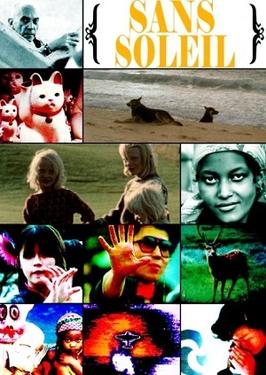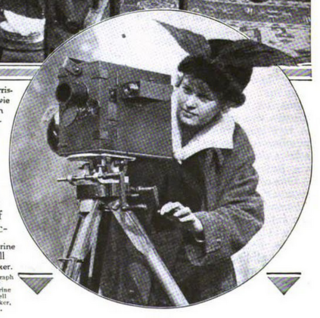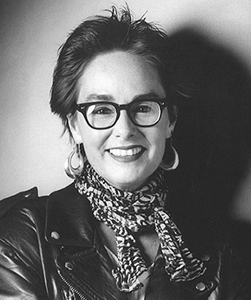
The Poston Internment Camp, located in Yuma County in southwestern Arizona, was the largest of the 10 American concentration camps operated by the War Relocation Authority during World War II.

Sans Soleil is a 1983 French documentary film directed by Chris Marker. It is a meditation on the nature of human memory, showing the inability to recall the context and nuances of memory, and how, as a result, the perception of personal and global histories is affected. The title Sans Soleil is from the song cycle Sunless by Modest Mussorgsky, a brief fragment of which features in the film. Sans Soleil is composed of stock footage, clips from Japanese movies and shows, excerpts from other films as well as documentary footage shot by Marker.
Takashi FujimotoASC is a retired American cinematographer. He is known for his collaborations with directors Jonathan Demme, M. Night Shyamalan and John Hughes. He is a Primetime Emmy Award winner, and a BAFTA and Satellite Award nominee. In 2016, he was named one of the 11 best cinematographers to have never won an Academy Award.

Hiro Narita is a Japanese-American cinematographer.

Don Ed Hardy is an American tattoo artist known for his tattoos, strong influence on the development of modern tattoo styles, and his eponymous apparel and accessories brand.
Joani Blank was an American sex educator, entrepreneur, author, videographer, cohousing enthusiast, philanthropist, and inventor in the field of sexuality. She used publishing, her sex store, and other endeavors to promote sex-positive feminism. Her papers are part of the Human Sexuality Collection at Cornell University Library.
On November 26, 2006, radio host Jerry Klein of WMAL 630 AM had a program that was "focused on public reaction to the removal of six imams, or Islamic religious leaders, from a US Airways flight." In an effort to gauge his audience's reaction, he said that force should be applied to ensure that all Muslims in America wear "identifying markers. ...I'm thinking either it should be an arm band, a crescent moon arm band, or it should be a crescent moon tattoo. ...If it means that we have to round them up and do a tattoo in a place where everybody knows where to find it, then that's what we'll have to do."
Rea Tajiri is an American video artist, filmmaker, and screenwriter, known for her personal essay film History and Memory: For Akiko and Takashige (1991).

Steven Toll Okazaki is an American documentary filmmaker known for his raw, cinéma vérité-style documentaries that frequently show ordinary people dealing with extraordinary circumstances. He has received a Peabody Award, a Primetime Emmy and has been nominated for four Academy Awards, winning an Oscar for the documentary short subject, Days of Waiting: The Life & Art of Estelle Ishigo.

Cary Joji Fukunaga is an American filmmaker. He is known for directing critically acclaimed films such as the thriller Sin nombre (2009), the period drama Jane Eyre (2011), the war drama Beasts of No Nation (2015) and the 25th James Bond film, No Time to Die (2021). He also co-wrote the Stephen King adaptation It (2017). He was the first director of East Asian descent to win the Primetime Emmy Award for Outstanding Directing for a Drama Series, as the director and executive producer of the first season of the HBO series True Detective (2014). He also directed and executive produced the Netflix limited series Maniac (2018), and executive produced and directed several episodes of the Apple TV+ miniseries Masters of the Air (2024).

Dim Sum: A Little Bit of Heart is a 1985 American comedy film directed by Wayne Wang and starring Laureen Chew, Kim Chew, Victor Wong, Ida F. O. Chung, Cora Miao, Amy Hill, and Joan Chen.

Alexis Krasilovsky is an American filmmaker, writer and professor. Krasilovsky's first film, End of the Art World documented artists including Andy Warhol and Robert Rauschenberg. Krasilovsky moved from New York to Los Angeles in the 1970s to pursue filmmaking, writing and directing through her company, Rafael Film. She is the writer and director of the documentary features, Women Behind the Camera and Let Them Eat Cake.

Jessie Maple was an American cinematographer and film director most noted as a pioneer for the civil rights of African Americans and women in the film industry. Her 1981 film Will was among the first feature-length dramatic films created by an African American woman.
Linus SandgrenFSF, ASC is a Swedish cinematographer, known for his collaborations with directors Damien Chazelle, David O. Russell, Gus Van Sant, and the duo of Måns Mårlind and Björn Stein. He is known for his use of unique and unconventional formats, shooting Van Sant's Promised Land in 4-perf Super 35mm 1.3x anamorphic for a 1.85:1 aspect ratio and Chazelle’s First Man on a variety of different formats: Super 16mm, 35mm Techniscope, Super 35 3-perf, and IMAX 70mm film.
Rachel Pearl Maines is an American scholar specializing in the history of technology. Since 2015 she has been a visiting scientist at Cornell University's School of Electrical and Computer Engineering. Her book The Technology of Orgasm won the American Historical Association's Herbert Feis Award. The book was also the inspiration for the film Hysteria and the play In the Next Room. However, one of the main claims of the book has been debunked as false.

Katherine Russell Bleecker, later in life Katherine Bleecker Meigs and later still Katherine B. Jobson, was an American filmmaker in the silent film era. She is sometimes credited as the first professional camerawoman in American film.
Juliana Wang was an American cinematographer. She was one of the first members of the National Association of Broadcast Employees and Television in New York and was one of the first female directors of photography in the IA Local 644 union. In 1978, she and colleague Alicia Weber won an Emmy award for cinematography.
Emiko Nakano (1925–1990) was an American abstract expressionist painter, printmaker, fiber artist, and fashion Illustrator.

Judith Carol Irola was an American cinematographer, film producer, and director. The third woman accepted into the American Society of Cinematographers, she was head of the cinematography department at USC School of Cinematic Arts for 15 years and held the Conrad Hall Chair in Cinematography there. Irola co-founded a National Association of Broadcast Employees and Technicians branch in San Francisco in 1969, and was a founding member of the short-lived Cine Manifest film collective in 1972.













